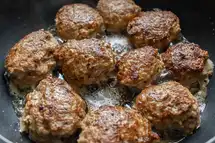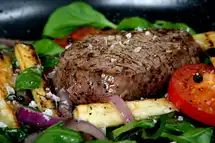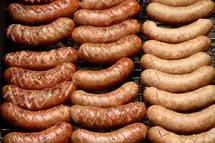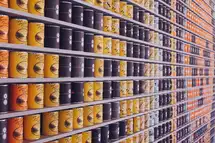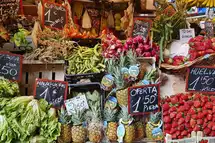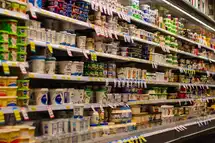What is a food storage temperature chart ?
A food storage temperature chart is a guide that gives you the recommended temperatures at which different types of food should be stored.
Food Storage Temperature Chart - Guidelines to Keep Your Food Fresh and Safe
What is Food Storage Temperature?
Food storage temperature is the ideal temperature range at which food should be stored to keep it safe and fresh and to prevent spoilage. Some foodslike meat and poultryrequire lower temperatures to hold. This temperature range helps to slow down or stop the growth of microorganisms like bacteria and mold, that could contaminate the food, causing illness if consumed. In addition, certain foods require cooler temperatures because microbes naturally form in those foods, causing them to rot faster than they ought to.
There are quite a few food storage rules people need to know about. And when it comes to food storage temperature, the rules must not be treated lightly. For example, the temperature of food heated up for consumption must remain between 140 F and 165 F for at least 15 seconds, whether it's meat, poultry or fish. Anything below this will give the bacteria time to multiply and increase the risk of infection and threaten Food Safety.
In short, hot foods must stay hot (above 140 F) and cold foods must stay cold (below 40 F). Most bacteria grow rapidly between 40 F and 140 Fwhat is referred to as the danger zone. When the bacteria level is low, the risk is also usually low, but over time other conditions like temperature, moisture, and so on, cause bacteria to multiply. This increases the risk of contamination.
What Does Storage Temperature Have to do With Food Safety?

Food is perishable. It can spoil if not stored properly. The right storage temperature determines how long your food will last and whether or not you'll get sick after eating it. One can control the bacterial growth that spoils foods and causes illness by controlling the storage temperature.
Bacteria thrive in warm, moist environments, so keeping food cold slows down the growth of bacteria and prevents them from multiplying. As a general rule of thumb, meat, poultry, fish, and eggs should be refrigerated at 40 F or below to remain safe to eat. Dairy products should also be kept cold, at around 38 F. Some food items are more perishable than others and require special care when storing. For example, leafy greens like spinach and lettuce should be kept in a cool (but not ice-cold) environment to prevent them from wilting. Fruits like berries and grapes can mold quickly if too warm, so they should also be stored in the fridge.
However, the relationship between food safety and storage temperature is a bit more complex. While storage temperatures are an important aspect of food safety, other factors must be considered. For instance, the type of food and packaging can affect how quickly (or slowly) spoilage occurs in the fridge. Storing foods in appropriate containers that allow airflow while keeping bugs and moisture content down ensures your food is protected. Knowing where to put what kinds of foods is also important. For example, storing meats, raw fish, and poultry below other food items helps because leakage is avoided.
If food is not stored at the proper temperature, it can go bad and cause food poisoning.
Maintaining the correct food storage temperatures is essential to keeping your food fresh and safe.
What are the steps to follow for Food Safety?

According to the United States Centers for Disease Control (CDC), each year 48 million peopleor one in six Americanssuffer illness due to foodborne diseases. Many of these illnesses could be prevented if food industry professionals practiced good temperature control measures. CDC's Food Safety guidelines are simple and easy to follow. Food safety can be ensured by following four simple steps Clean, Separate, Cook, and Chill.
Foodborne illnesses are spread through contact with germs, therefore, cleanliness is important. Here are some of the steps to follow to keep Food Safe.
- Thoroughly wash hands with soap before, during, and after preparing foods and before eating.
- Washing dishes, boards, and other surfaces between cooking different types of foods.
- Rinse fresh fruits and vegetables by submerging them twelve inches under running tap water to fully remove pathogens or bacteria that may cause foodborne diseases
Now, coming to the temperature. By cooking foods at the right temperature, one can control the levels of bacteria that spoil foods and cause illness. Heat kills bacteria, and cold temperatures slow down the growth of bacteria and other microorganisms, preventing them from reaching harmful levels. When cooked, the food's internal temperature rises, killing germs that can cause foodborne illness. Whole cuts of beef, lamb, pork and veal, including fresh ham (raw), should reach an internal temperature of 145 F. Ground meats like pork and beef should have an internal temperature of 160 F
Refrigeration, the final step in the CDC's guidelines, helps reduce the growth of harmful bacteria. Bacteria jumpstart their multiplication fastest in temperatures between 40 F and 140 F (Danger Zone).
Storage Temperatures for Meats and Poultry

Meats are especially susceptible to harmful bacteria. Compared to other foods, is meats and poultry products are not handled and stored properly, they can cause a host of foodborne illnesses, ranging from Bovine Spongiform Encephalitis to E. coli.
It is therefore vitally important to maintain safe food storage temperatures. The temperature of meat and poultry products must be carefully monitored to avoid the risk of foodborne illnesses. For instance, in case of a power outage, one must Make Sure to transfer meat products to a place where the necessary storage temperature is maintained. If these food safety rules cannot be observed, the meat must be discarded to avoid risk of contamination. In addition, raw products must always be stored at a temperature below cooked or ready to eat products.
The food storage temperature chart below outlines the temperatures and conditions in which meat and poultry products can be kept safely-
| Food items | Store at room temperature (50 to 70 F). | Refrigerate (at 40 F or below) | Freeze (at 0 F or below) |
| Raw meats- pork (roasts, steaks, chops), beef, lamb, or veal | Not safe | Three to five days | Four to twelve months |
| Ground meats (beef, pork, veal, lamb, stew) | Not safe | One to two days | Three to four months |
| Bacon | Not safe | If unopened, within one week of the 'Use by'' date on the packet. Unopened, one week. | One month |
| Sausage or raw meat from beef or pork | Not safe | One to two days | Three to four months |
| Ham, fully cooked, store-wrapped, slices, half or spiral cut | Not safe | Three to four days | One to two months |
Storage Temperatures for Vegetables
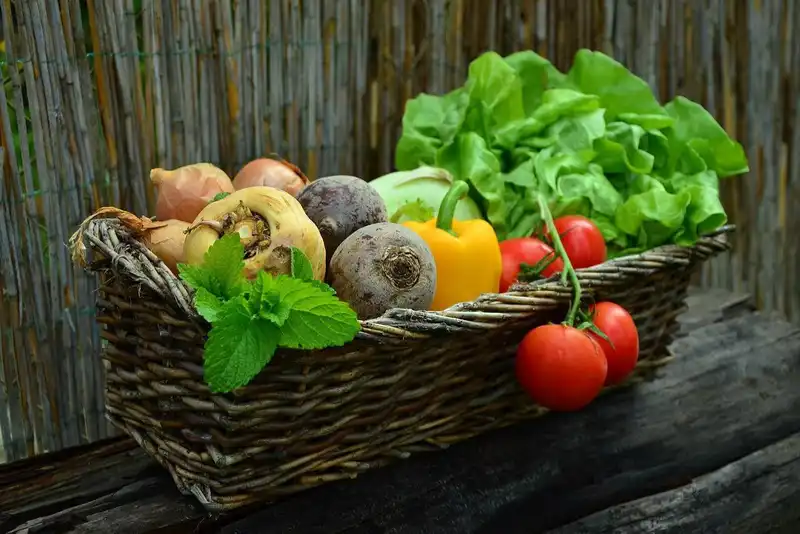
Fruits and veggies purchased in canned, dried, or frozen form can be stored in your pantry or freezer. But any food tastes better and is healthier when it's fresh. Fresh produce is the best choice if you're able to find it. However, figuring out how to store fresh foods properly can be tricky. It's important to remember that anything that begins to spoil can become dangerous for your health.
A good example of this is grapesthey often grow mold if not stored properly. Or ripe bananas that turn black if left at room temperature. Leafy greens start wilting. These items are delicate in their natural state. But certain methods can help prolong their shelf-life. For instance, peeling and freezing bananas can keep them fresh longer. Washing leafy greens under running water before freezing can help.
Proper storage temperatures can prevent a host of food problems. Refrigerating fresh fruits and vegetables is the best way to store them for the long term. Most fruits and veggies do well at 40 F or below, but some fresh produce, such as potatoes and onions, may need slightly warmer temperatures. Unripe bananas and avocados should not be refrigerated either.
One thing to remember is that extra water can spoil fresh produce very quickly. A crisper drawer can take care of this problem. The crisper lets the right amount of air pass through the fresh produce to keep it from losing too much moisture. It also ensures that excess water doesn't collect, preventing molding and helping the fruits and vegetables remain fresh longer.
Food can spoil if it isn't stored at the right temperature.
This handy food storage temperature chart tells you what the storage temperatures are for different foods.
Storage Temperatures for Fish and Eggs

Fish, shellfish, and shrimps are among the healthiest food items around. They provide essential nutrientsincluding high-quality proteinthat the body needs to stay healthy. In addition, fish and shellfish contribute to heart health and aid in children's growth and development. But like with other foods, precautions must be taken when storing them.
Seafood safety begins at the market. For instance, one should only buy fish that is refrigerated or displayed on a cool bed of fresh ice beneath the counter. Make sure the fish doesn't have an ammonia-like smell; it should smell fresh with only a mild odor.
In addition, all seafood products include a temperature/time indicator on the package that tell you whether the product has been kept cold enough to avoid contamination. Check these indicators well and never buy a product if it isn't certified. Always ask sellers about their process for storing seafood.
Now on to eggs. This food can cause Salmonella food poisoning. The pathogen Salmonella is known to be present on the surfaces of eggs, and improper handling can lead to contamination. The United States Food and Drug Administration (FDA) has guidelines in place to prevent egg contamination. These are under four broad categories- how to buy, store, prepare, and serve eggs. Like any seafood, the process begins at the market. Eggs are typically sold in sealed packages; but if their shells are cracked or dirty, if the package is punctured, you should discard it. Once bought, eggs should be promptly stored at 40 F or below in the refrigerator.
The food storage chart below has FDA-approved guidelines for storing seafood and eggs.
| Food items | Store at room temperature (50 to 70 F). | Refrigerate (at 40 F or below) | Freeze (at 0 F or below) |
| Raw fish and shellfish | Not safe | One to two days | Three to eight months (the flavor and texture will diminish with time.) |
| Cooked fish, shellfish and other seafood | Not safe | Three to four days | Three to four months |
| Canned fish (commercial), such as tuna | Not safe | If unopened, for five years or till 'Use by' date on the packet. Opened, one week. | |
| Raw eggs | One to two days | Three to five weeks | |
| Hard boiled eggs | Not safe | One week | One to two months |
Final Word
Wrap, mark and store food items properly to keep them safe and prevent yourself from falling ill from food poisoning. Right storage also decreases food waste by ensuring leftovers don't end up in waste bins.
It's important to remember that when it comes to food, it isn't just the preparation that's vital, but the storage too. You'll want to put items like cooked seafood, raw meats, fruit and vegetables in airtight bags with absorbent material (paper towels or napkins) to soak up spills and prevent the juices from mixing up or spoiling other items in the refrigerator. Practices like this go a long way in preventing bacteria from developing and reducing the risk of contamination and foodborne illnesses.
Different foods have different storage temperatures.
It's important to know what they are if you want to keep your food safe.








































